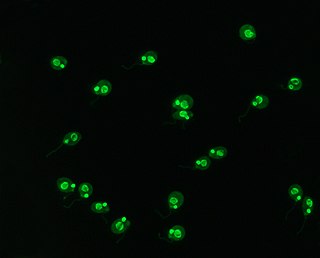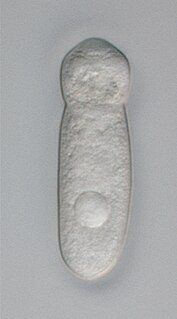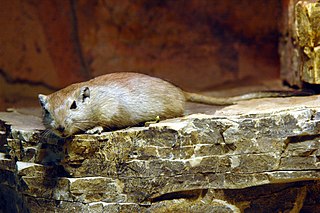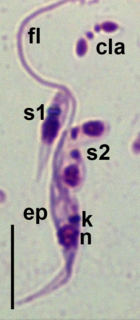
The Apicomplexa are a large phylum of parasitic alveolates. Most of them possess a unique form of organelle that comprises a type of plastid called an apicoplast, and an apical complex structure. The organelle is an adaptation that the apicomplexan applies in penetration of a host cell.

The heterotrichs are a class of ciliates. They typically have a prominent adoral zone of membranelles circling the mouth, used in locomotion and feeding, and shorter cilia on the rest of the body. Many species are highly contractile, and are typically compressed or conical in form. These include some of the largest protozoa, such as Stentor and Spirostomum, as well as many brightly pigmented forms, such as certain Blepharisma.

A polyphyletic group is a set of organisms, or other evolving elements, that have been grouped together but do not share an immediate common ancestor. The term is often applied to groups that share characteristics that appear to be similar but have not been inherited from common ancestors; these characteristics are known as homoplasies, and the development and phenomenon of homoplasies is known as convergent evolution. The arrangement of the members of a polyphyletic group is called a polyphyly.

Morphology is a branch of biology dealing with the study of the form and structure of organisms and their specific structural features.

Crithidia is a genus of trypanosomatid Euglenozoa. They are parasites that exclusively parasitise arthropods, mainly insects. They pass from host to host as cysts in infective faeces and typically, the parasites develop in the digestive tracts of insects and interact with the intestinal epithelium using their flagellum. They display very low host-specificity and a single parasite can infect a large range of invertebrate hosts. At different points in its life-cycle, it passes through amastigote, promastigote, and epimastigote phases; the last is particularly characteristic, and similar stages in other trypanosomes are often called crithidial.

The gregarines are a group of Apicomplexan alveolates, classified as the Gregarinasina or Gregarinia. The large parasites inhabit the intestines of many invertebrates. They are not found in any vertebrates. However, gregarines are closely related to both Toxoplasma and Plasmodium, which cause toxoplasmosis and malaria, respectively. Both protists use protein complexes similar to those that are formed by the gregarines for gliding motility and invading target cells. This makes them excellent models for studying gliding motility with the goal of developing treatment options for toxoplasmosis and malaria. Thousands of different species of gregarines are expected to be found in insects, and 99% of these gregarines still need to be described. Each insect can be the host of multiple species. One of the most studied gregarines is Gregarina garnhami. In general, gregarines are regarded as very successful parasites, as their hosts are spread over the entire planet.
The long-tailed armored tree-rat, Makalata macrura, is a spiny rat species from South America. It is found in Brazil, with a population in Ecuador which is referable either to this species or to Makalata didelphoides. Initially considered a large form of the latter species, it actually represents a distinct species as supported by morphological and molecular characters.

Lemniscomys, sometimes known as striped grass mice or zebra mice, is a genus of murine rodents from Africa. Most species are from Sub-Saharan Africa; L. barbarus is the only found north of the Sahara. They are generally found in grassy habitats, but where several species overlap in distribution there is a level of habitat differentiation between them.
Neusticomys is a genus of semiaquatic South American rodents in the family Cricetidae.

Psammomys is a genus of rodents in the family Muridae.
The Peruvian tree rat is a species of rodent in the family Echimyidae. It is found in northeastern Peru and adjacent Ecuador, where it is found in the Amazon rainforest. It is nocturnal and arboreal.
The Archigregarinorida are an order of parasitic alveolates in the phylum Apicomplexa. Species in this order infect marine invertebrates — usually annelids, ascidians, hemichordates and sipunculids.
The Eugregarinorida are the most large and diverse order of gregarines — parasitic protists belonging to the phylum Apicomplexa. Eugregarines are found in marine, freshwater and terrestrial habitats. These species possess large trophozoites that are significantly different in morphology and behavior from the sporozoites. This taxon contains most of the known gregarine species.
Protoheterotrichida is an order of karyorelict ciliates. It contains the family Geleiidae.

Gregarina garnhami is a eukaryotic unicellular organism belonging to the Apicomplexa described in 1956 by Canning as a parasite found in several locusts, such as the desert locust, African migratory locust, and Egyptian locust. Especially, the desert locust is the host for this species, as up to 100% of animals can become infected. An estimated thousands of different species of gregarines can be in insects and 99% of these gregarines still need to be described. Each insect is said to host multiple species. A remarkable feature of G. garnhami is its auto-fluorescence.

Blastocrithidia is a genus of parasitic flagellate protist belonging to the family Trypanosomatidae. It is a monoxenous parasite of heteropteran insects, mainly inhabiting their hindgut and glands.

Leptomonas is a genus of parasitic flagellate protist belonging to family Trypanosomatidae and subfamily Leishmaniinae sensu Maslov & Lukeš 2012. It is a monoxenous parasite of mainly Hemiptera, Diptera, and Siphonaptera insects.

Heteroxeny, or heteroxenous development, characterizes a parasite whose development involves several host species. Heteroxeny has been used as the basis for splitting genera.
Leptorhabdos is a monotypic genus of flowering plants, initially classified in Scrophulariaceae, and now within the broomrape family Orobanchaceae. It contains a single species, Leptorhabdos parviflora.

Crossopetalum, commonly known as Christmas-berries or maiden berries, is a genus of flowering plants in the family Celastraceae. It comprises about 30-40 species.













